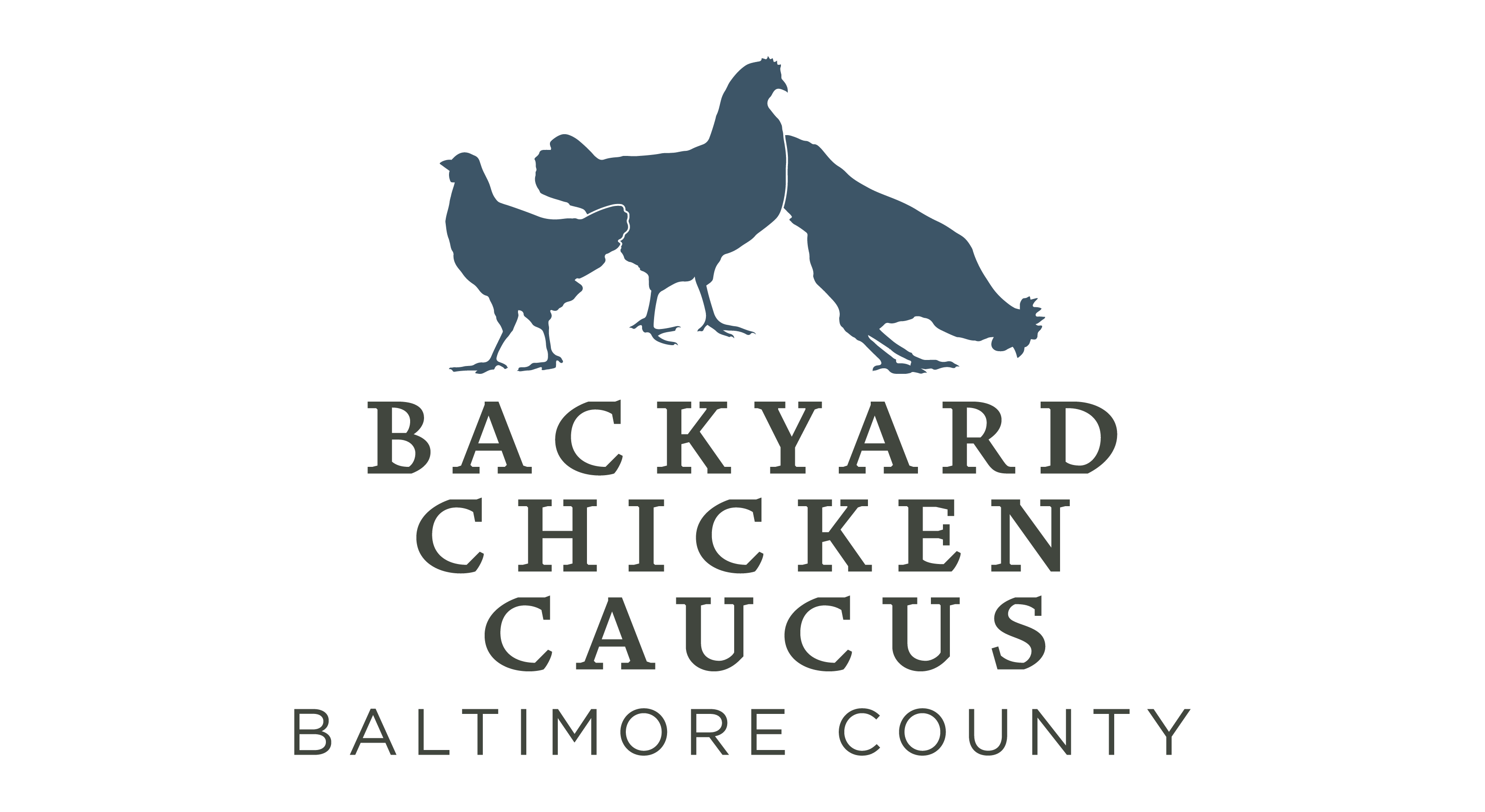CHICKEN MYTHS VS. FACTS?
After speaking with friends, relatives and neighbors, the Backyard Chicken Caucus realized that there are several misconceptions out there about backyard chickens. So here are some common myths and the facts to clear things up.
MYTH: Chickens attract rODENTS
FACT: Pet chickens DO NOT attract rats.
Chickens do not attract rats. A survey of reputable government publications on rat behavior, attractants and management did not find a single mention of chickens attracting rats.1 These publications included CDC guidance2 and Baltimore County’s own guidance3. In fact, we have not been able to find a single scientific source that indicates that chickens may attract rats to a neighborhood, this is a myth based in fear not science. Chickens do not attract rats– however chicken food, if improperly stored can be a food source for rats, just like improperly stored cat food, dog food or birdseed can. The number one attractant for rats across publications, are poorly secured garbage cans4.
Storing chicken feed in a tightly closed metal container, using feeders that prevent excessive food spillage, and tucking feeders away at night are simple, successful measures that can be taken to eliminate any potential food storage issues.
Rather than banning cats, dogs, trash cans and bird feeders, we take a more measured approach and cite people who store these things improperly. There is no reason to treat chickens differently. In comparison with trash cans, they represent a fractionally small portion of the potential problem.
Fun Fact: Did you know that chickens are voracious omnivores? They will chase and eat just about anything that moves including ticks (which spread Lyme disease), fleas, mosquitoes, grasshoppers, stink bugs, slugs, mice, rats and small snakes.
MYTH: Chickens ARE DIRTY
FACT: Chickens are very clean and very healthy pets
Chickens are tidy animals by nature and if they are well cared for, they pose no significant health or safety risks according to research.
Currently, all flocks of five or more birds are required to register with the State of Maryland. In the event of an outbreak, these birds can be inspected/monitored for illness.
A study looking into potential health risks associated with backyard flocks concludes that reasonable care in handling chickens and hand-washing provides adequate protection against disease, stating “…public health scholars have found no evidence that the incidence of disease in small flocks of backyard hens merits banning hens.” The Centers for Disease Control (CDC) concurs in its publications on Salmonella.
A Penn State study concluded that very few diseases can be transmitted by poultry to humans.5 The 2006 Grain Report states: ‘‘When it comes to bird flu, diverse small-scale poultry is the solution, not the problem.’’6
Avian flu problems occur in huge overcrowded chicken farming conditions, when a bird’s natural immunity is compromised. One diseased animal will immediately affect hundreds or thousands of others. The Johns Hopkins School of Public Health states on its website: ‘‘In the United States there is no need at present to remove a flock of chickens because of concerns regarding avian influenza.’’7 This same conclusion is drawn by the Centers for Disease Control (CDC).8
Contrary to the peaceful nature of chickens, approximately 4.7 millions dog bites occur in the US each year. Dog bites can infect victims with diseases including rabies, and cause severe injury and death. Per statistics kept by the US Humane Society, 800,000 of these incidents require medical treatment, and result in about 30 fatalities.9
Fun Fact: Chickens don’t bathe in water like humans do – they bathe in dust. The fine particles in dust help to keep a chicken’s feathers clean. When a chicken is ready for a dust bath, they will dig a small ditch, then roll around in it until the dirt under their feathers are completely coated. Then, they will stand up, shake it all out, and preen themselves
MYTH: Chickens REQUIRE SEPARATE COUNTY ENFORCEMENT
FACT: Pet chickens do not require separate county enforcement.
If dogs or cats are being kept in unclean, inhumane conditions, neighbors have a right to call Animal Control to remove the animal per existing law. This is no different when it comes to backyard chickens.
From Jan 1, 2018 – Jan 1, 2021 there were 773 animal complaints in Baltimore County. ONLY TWO referenced chickens and neither were directly related to backyard chickens: ACCMP-2020-06168 and ACCMP-2019-11700.
Pet chickens have the potential to provide a substantial source of revenue for the county through registration and licensing fees. Enabling more owners to acquire pet chickens legally benefits local vendors and local agricultural/educational providers as well.
MYTH: Chickens DECREASE PROPERTY VALUE
FACT: Property values and pet chickens are completely unrelated to one another.
Chickens have steadily gained popularity as backyard pets. The USDA estimates that by 2019 urban and suburban chicken flocks increased by 400%. Martha Stewart, the ultimate indicator of suburban chic, keeps heritage breed chickens.
There are many anecdotal cases of chickens actually increasing property value and zero documented cases of backyard chickens affecting property values.
As concerns related to climate and environmental changes grow, many families actively seek out communities that support sustainable practices such as keeping pet chickens.
Fun Fact: Just to name a few additional celebrity chicken owners – Julia Roberts, Barbara Streisand, Jennifer Aniston, Jennifer Garner, Lady Gaga, and Reese Witherspoon all own pet chickens.
MYTH: Chickens ARE SMELLY ANIMALS
FACT: Pet chickens are non-smelly, non-toxic, organic gardening companions.
There is often a perception that chickens have a strong smell, but a well cared for flock and coop have little to no odor. Any animal that is poorly cared for will start to develop an odor, dogs and cats included. Chickens are prized for their ability to turn scraps and waste materials into nitrogen rich compost. Chicken waste is non toxic, is entirely contained within the few square feet that comprise the chicken coop and run, is safely compostable, and can be used as valuable fertilizer.
Even a well maintained coop that needs to be cleaned will not generate noxious odors that are noticeable more than two or three steps back from the coop. All domestic pets produce waste, and must be cared for properly. However, there are important differences in comparison with chickens.
- A 60-lb. dog generates about 1 pound per day of solid waste, which is about the same amount as 8 chickens.10
- Dog waste is toxic. It contains pathogens such as parasites and dangerous bacteria, and must be handled as a biohazard. It is the main cause of a long list of diseases. Per the EPA, dog waste is classified as toxic along with pesticides, mine tailings and numerous other chemicals.11 Additionally, dog waste can transmit parasites and disease and is unsafe to compost at home.12
- Chicken droppings are non-toxic. The waste breaks down through natural composting in as little as 3-4 weeks, and provides very beneficial fertilizer for the homeowner. A 20-lb. bag of organic dried chicken manure sells for $15 as fertilizer.
- Dog waste is difficult to clean up thoroughly in backyards, because it is scattered around, and cannot be completely removed without digging up dirt, grass or plants around it. Dog owners routinely have to settle for removing 95% (not 100%) of the solid waste left by dogs, and 0% of the liquid waste.
- Chicken waste—liquid and solid—is completely contained inside the coops and enclosures under normal circumstances. It can be removed and composted in just a few minutes per week. It’s mild enough to be applied directly to a small garden for those who don’t wish to maintain a compost pile.

MYTH: Chickens ARE LOUD
FACT: Chickens are a pretty quiet pet…
At their loudest, chickens cackle for a few minutes each day right before or right after laying an egg. The noise level is about the same as human conversation (60 to 70 decibels.13) During the rest of daylight hours, they make very low and pleasant cooing or clucking noises.
As a matter of instinct, chickens roost and sleep when the sun goes down, so they make no noise at all during the night. By contrast, dogs and cats can be a nuisance by barking or growling loudly around the clock.
The City of Pleasanton, CA did a study of noise from chickens, and found that they were always within the allowed limits, and further that ‘‘they are also generally less than the volume of normal conversation.”14

MYTH: Chickens NEED LOTS OF SPACE
FACT: Pet chickens require less space than an average backyard jungle gym.
Chickens require less space than cats or dogs. Chickens require between 2 and 6 sq ft per bird. Using the high end of this recommendation, one could legally house 7,260 chickens on an acre and 0 on .95 acres. We are not suggesting anyone keep that many birds because it’s absurd, however it would be permissible under the current legislation.
According to the Federal Agriculture Organization of the United Nations (FOA) one needs 3.6 feet squared per bird to safely raise chickens. More conservative estimates suggest 10 sq ft per bird.15

2CDC Urban Rat Survey Criteria: (Food Sources and Harborage pgs: 14-17) https://www.cdc.gov/nceh/ehs/docs/ipm_manual.pdf
3https://www.baltimorecountymd.gov/departments/permits/ratattack/ratcontrol.html
4CDC Urban Rat Survey Criteria: (Food Sources and Harborage pgs: 14-15) https://www.cdc.gov/nceh/ehs/docs/ipm_manual.pdf
5 http://vbs.psu.edu/extension-1/copy_of_resources/pdf/infectious-disease-info/VSE-06- 03.pdf/view
7 http://www.jhsph.edu/news/_archive/special-stories/flu/morefaq.html
8 http://www.cdc.gov/flu/avian/gen-info/qa.htm
9 www.americanhumane.org/animals/stop-animal-abuse/fact-sheets/dog-bites.html
10 http://ohioline.osu.edu/aex-fact/pdf/0715.pdf
11 http://www.epa.gov/owow/nps/qa.html
12 USDA Composting Dog Waste https://www.nrcs.usda.gov/Internet/FSE_DOCUMENTS/nrcs142p2_035763.pdf and https://www.gardeningknowhow.com/composting/manures/dog-waste-in-compost.htm
© Copyright 2021. All Rights Reserved.

